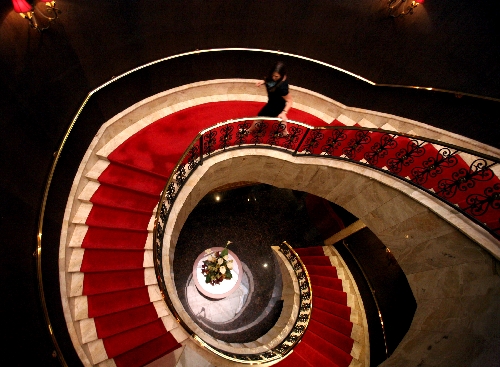Downtown’s El Cortez seeking historic designation
Vice-loving history buffs rejoice. Someone finally wants to marry historic preservation with free booze for gamblers.
Owners of the El Cortez are attempting to list the iconic downtown Las Vegas hotel-casino on the National Register of Historic Places.
If they succeed, it would burnish the property's cultural cachet with history lovers and, perhaps as importantly, infuse some good old-fashioned adult entertainment into a list cluttered with old schools and government buildings.
"Having a property such as the El Cortez that represents the early days of gaming and entertainment is absolutely critical," said architectural historian Peter Moruzzi, who is compiling the El Cortez application. "Every city has courthouses, city halls, old banks and old hotels."
The El Cortez application is largely complete but still needs approval from Las Vegas city officials, the Nevada State Historic Preservation Office and the National Park Service before it can be listed. The application is based mostly on the fact the El Cortez facade on Fremont and Sixth streets has barely changed since the first card was dealt there in 1941.
"Getting a hotel-casino that maintains its integrity is really difficult," said Nevada state historic preservation officer Ron James, echoing a sentiment familiar to anyone whose favorite Las Vegas casino succumbed to implosion. "The market is competitive for the new, not celebrations of the old."
There are 50 Clark County places on the registry, according to the Nevada State Historic Preservation Office. The list includes the Boulder Dam Hotel in Boulder City and the Fifth Street School and the site of the former Moulin Rouge in Las Vegas.
Other long-lasting local casino properties include the Golden Gate, which is in a building that opened as Las Vegas' first hotel in 1906, and Railroad Pass in Henderson, which first opened in 1931. Neither is listed on the national register.
The Riverside and El Cortez hotels in Reno are on the national register, but neither has an active casino. Virgina City, which has gambling, is on the register, but it is listed as a historic district, not for any specific casino.
The El Cortez architecture is considered significant because it is an example of a Spanish Colonial Revival style with a Western flair, which was popular in the Western United States around the time of World War II.
Another significant factor in the case for the listing is the El Cortez's role in the development of Las Vegas.
When the El Cortez opened, Fremont Street was the economic and cultural soul of the city. It would be another decade before new properties on the Strip began chipping away at downtown's dominance.
The El Cortez's distinctive rooftop neon sign was added in 1952, parking garages arrived in 1970 and 1976, and a 15-story hotel tower was finished in 1984, according to the application. But the original exterior looks much as it did in the 1940s.
General manager Mike Nolan, who said he started working for longtime El Cortez owner Jackie Gaughan in 1978, said that in the 1980s there were plans to build over the original structure.
"There were drawings," Nolan said. "Did it get rejected because of historical significance or because of money or something? I don't know that."
Although the listing application builds its case on design, architecture and setting, Moruzzi's research dug up long-buried documentation of the El Cortez's importance to Las Vegas' mob history.
It's no secret early owners of the El Cortez included Moe Sedway, Gus Greenbaum and other associates of prominent mobsters Benjamin "Bugsy" Siegel. But Moruzzi was surprised to unearth a deed from 1945 that included Sedway's name, among other mob associates.
"That deed is a big deal. As far as I know no one has ever dug up that document," Moruzzi said. "It has their names on it, it is not like it is just a rumor."
College of Southern Nevada historian Michael Green concurred that converting more of Las Vegas' past from the land of lore to the world of established facts would be good for the community.
Green, who contributed research to the National Museum of Organized Crime and Law Enforcement, aka the Mob Museum, said separating fact from myth is particularly challenging in Las Vegas, where many of the city's founding fathers avoided written evidence of their business connections.
"There is an old Woody Allen line: Organized crime saves a lot of money on office supplies," Green said.
Once representatives for Siegel, Meyer Lansky and their ilk shifted their focus to the development of the Flamingo on the Strip, the ownership line of the El Cortez gained clarity and continuity.
In 1962 Gaughan, Mel Exber, Larry Hezzlewood and J. Kell Houssels Jr. took over, with Gaughan as operator. The property remained under his control until 2008, when he sold his stake to longtime business partner Kenny Epstein.
In recent years Alexandra Epstein, Epstein's daughter, has led a drive to integrate the El Cortez into the downtown revival led by Zappos CEO Tony Hsieh. The property has hosted events for tech startups and coordinates food truck events.
Epstein said being added to the national register would boost efforts to market the historic character of the property.
"Everybody is nostalgic for Vegas even if you have never been here," she said. "We are not classic Vegas-like. We are actual classic Vegas."
Contact reporter Benjamin Spillman at bspillman@reviewjournal.com or 702-383-0285 .


















